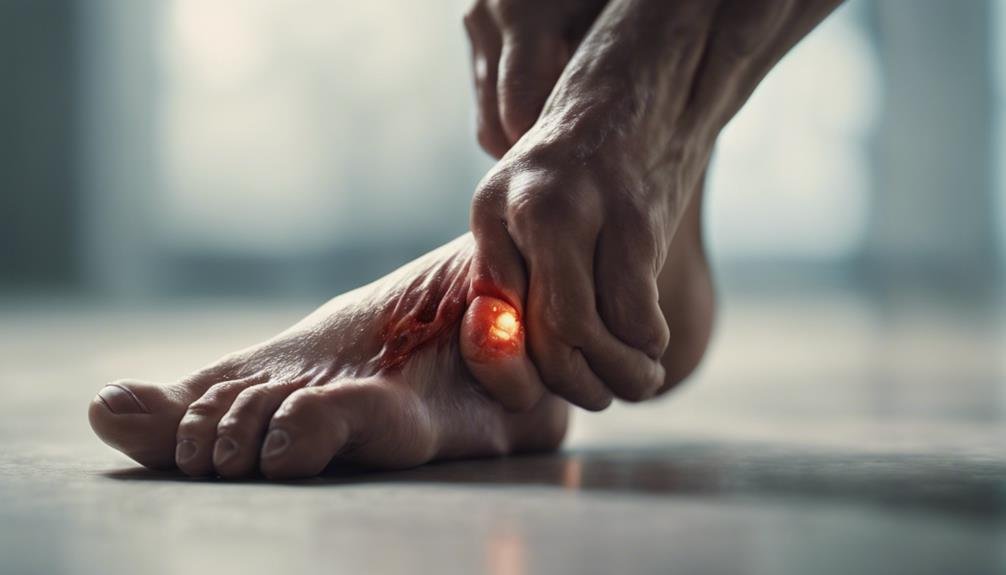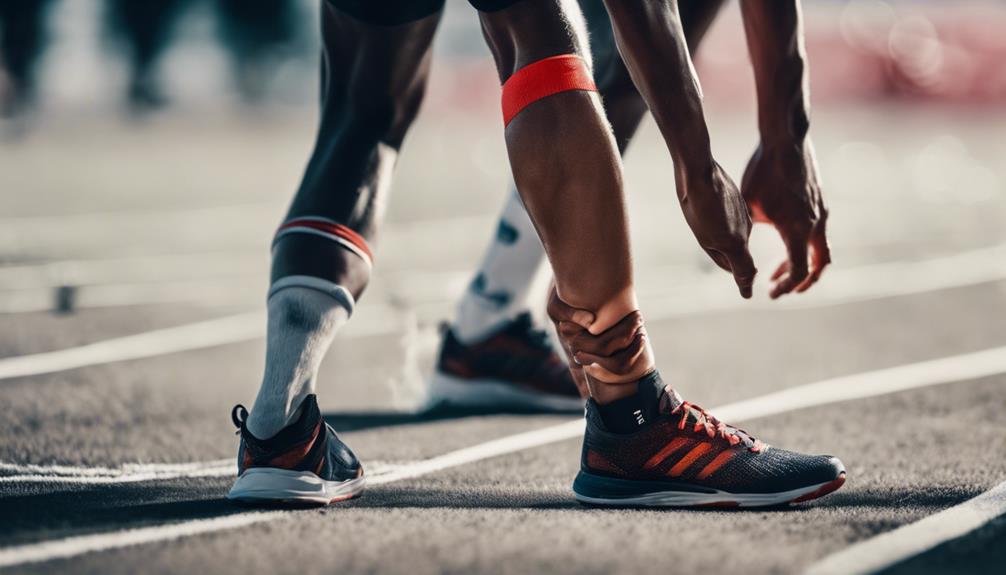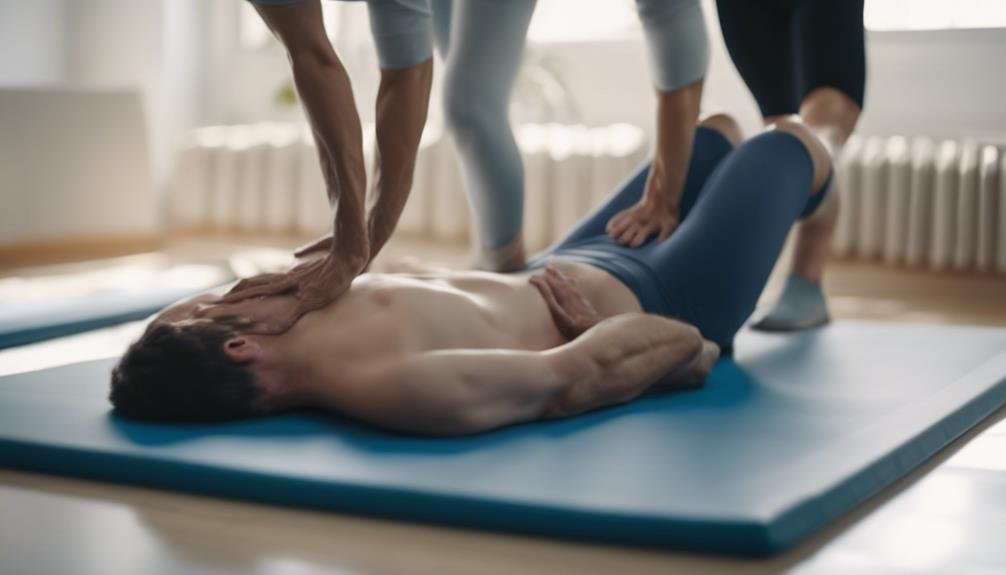Imagine you’re playing your favorite sport, and suddenly, you twist your ankle or feel a sharp pain in your shoulder. These acute injuries can happen instantly, disrupting your daily activities and causing significant discomfort. You might wonder how to distinguish a minor injury from one that requires medical attention or what immediate steps you should take for the best outcome. Understanding the different types of acute injuries and their treatments can significantly impact your recovery. So, what should you do next when an injury strikes?
Key Takeaways
- Acute injuries occur suddenly due to severe impacts or forces.
- Common types include fractures, sprains, strains, dislocations, and muscle tears.
- Immediate treatment involves protecting the area, applying ice, using compression, and ensuring rest.
- Seek medical help for severe pain, inability to bear weight, or visible deformity.
- Prevention includes proper warm-up, safety equipment, hydration, and regular exercise.
Types of Acute Injuries

Acute injuries, such as fractures, sprains, strains, dislocations, and muscle tears, happen suddenly due to impacts or trauma during physical activity. These injuries often bring immediate pain, swelling, and a limited range of motion, making it clear that something’s wrong.
Understanding the different types of acute injuries is vital for recognizing them and seeking prompt treatment. Fractures involve a break in the bone and can vary from minor cracks to severe breaks. They require immediate medical attention to guarantee proper alignment and healing.
Sprains occur when ligaments, the tissues connecting bones, are overstretched or torn. They commonly affect ankles or wrists. Strains involve muscles or tendons being overstretched or torn, often impacting the back or hamstrings.
Dislocations happen when bones are forced out of their normal positions at joints, causing intense pain and immobility and necessitating urgent medical intervention. Muscle tears involve ripping muscle fibers, typically resulting from sudden, forceful movements.
Prompt treatment is essential for all these acute injuries to prevent further damage and promote effective healing. Timely medical care can significantly impact your recovery and long-term health.
Common Causes
Sudden impacts or forceful movements during sports and physical activities often lead to acute injuries. Falls, collisions, and overexertion commonly cause these injuries. Football, basketball, and soccer are particularly prone to acute injuries due to their dynamic nature and frequent physical contact. For instance, a fall while skiing or a collision during a soccer match can result in fractures or sprains.
Poor technique and inadequate warm-up routines also contribute significantly to the risk of acute injuries. When you don’t warm up properly, your muscles and joints aren’t prepared for the stress of the activity, making them more susceptible to injury. Insufficient protective gear can turn a simple fall into a serious injury.
Here’s a quick overview of common causes of acute injuries:
| Cause | Example | Impact |
|---|---|---|
| Falls | Skiing, cycling | Fractures, sprains |
| Collisions | Football, basketball | Bruises, broken bones |
| Overexertion | Weightlifting, running | Muscle strains, ligament tears |
| Dynamic Sports | Soccer, rugby | Various acute injuries |
Understanding these common causes can help you take preventive measures to reduce the risk of acute injuries.
Symptoms to Watch For

When you suspect an acute injury, watch for sudden, severe pain at the impact site. This pain usually indicates something significant has happened.
Along with pain, you’ll often see swelling in the injured area. Swelling is one of the primary symptoms of acute injuries as your body responds to the trauma. Bruising or redness may also appear, signaling that blood vessels have been damaged.
Another critical symptom is a loss of function or range of motion. If you can’t move the affected part of your body as you normally would, this is a strong indicator of an acute injury.
Sometimes, you might even hear or feel a popping or snapping sensation at the time of injury. This sensation often points to ligament or tendon damage.
Immediate symptoms are just as telling. If you can’t bear weight on an injured limb or move it, these are serious signs that you’ve sustained an acute injury.
Always pay attention to these immediate symptoms, as they can help you quickly determine the severity of the injury and whether you need medical attention.
Immediate Treatments
To address an acute injury effectively, start by protecting the injured area to prevent further damage. Immediate treatments are essential in managing acute injuries. Begin by ensuring the affected area is shielded from additional stress or strain. Crucial rest is important for recovery, but don’t overdo it; excessive rest can lead to stiffness and delayed healing.
Ice application is another critical step. For the first 48 hours, apply ice to the injured area for 15-20 minutes every 1-2 hours. This helps reduce both pain and inflammation. Use a cloth or towel to avoid direct contact between the ice and your skin, which could cause frostbite.
Using compression wraps can provide necessary support and minimize swelling. Wrap the injured area snugly but not too tight, as you don’t want to restrict blood flow.
When to Seek Medical Help

Recognizing when to seek medical help for an acute injury can prevent complications and guarantee proper treatment. If you experience severe pain, inability to bear weight, or notice a visible deformity, it’s important to seek medical help immediately. Severe pain is your body’s signaling that something is seriously wrong.
In acute injuries, such as fractures or dislocations, timely medical attention can make all the difference in your recovery.
You should consult a healthcare professional if the injured area is swollen, painful to touch, or exhibits signs of infection, like redness or warmth. Deep cuts that won’t stop bleeding also require immediate medical attention to prevent excessive blood loss and infection.
For acute injuries involving head trauma, don’t delay in seeking help, as these can have serious, long-term consequences.
If you sustain an acute injury during sports or other physical activities, stop the activity immediately. Continuing to move can worsen the injury and lead to further complications.
Prevention Strategies
Preventing acute injuries begins with incorporating proper warm-up routines and using appropriate safety equipment. Start your warm-up with dynamic stretching to prepare your muscles and joints for the activity ahead. These movements increase blood flow and flexibility, reducing the risk of strains and sprains.
Equipping yourself with the right safety gear is another essential prevention strategy. Whether it’s helmets for cycling or pads for contact sports, using the correct safety equipment greatly lowers the risk of acute injuries.
Staying hydrated is also important. Proper hydration helps maintain muscle function and reduces the chance of cramps and heat-related injuries. Drink water before, during, and after activities to keep your body in good condition.
Your overall fitness level plays a crucial role in injury prevention. Regular exercise and conditioning strengthen your muscles and improve your endurance, making you less susceptible to acute injuries during physical activities.
Acute Vs Chronic Injuries

Understanding the distinction between acute and chronic injuries is essential for effective treatment and prevention. Acute injuries, like fractures, dislocations, sprains, strains, and muscle tears, happen suddenly, often from a severe impact or an abrupt movement. You’ll notice immediate pain, swelling, and loss of function, signaling the need for prompt evaluation and treatment. On the other hand, chronic injuries, also known as overuse injuries, develop over time due to repetitive motion or continued activity. These injuries, such as tendonitis or stress fractures, manifest gradually and can worsen if not addressed.
Here’s a quick comparison to help you differentiate between acute and chronic injuries:
| Aspect | Acute Injuries | Chronic Injuries |
|---|---|---|
| Onset | Sudden, severe impact | Gradual, over time |
| Examples | Fractures, dislocations, sprains | Tendonitis, stress fractures |
| Symptoms | Immediate pain, swelling, loss of function | Gradual pain, soreness, and stiffness |
Recognizing the differences between acute and chronic injuries can help you take appropriate action, whether you’re dealing with an acute sports injury or a chronic injury from repetitive strain. By understanding these differences, you’ll be better equipped to manage and prevent injuries effectively.
Treatment Options
Now that you know the difference between acute and chronic injuries, let’s explore the treatment options for managing acute injuries effectively.
One of the most common and immediate methods is the RICE protocol, which stands for rest, ice, compression, and elevation. Rest allows your body to heal without additional strain, and applying ice helps reduce pain and swelling. Compression through bandages or wraps stabilizes the injury and further minimizes swelling. Elevation keeps the injured area above the heart level, which aids in reducing inflammation.
Medical interventions like splinting, casting, or even surgery might be necessary in cases of more severe acute injuries. These options are essential for ensuring proper alignment and healing of bones and tissues.
Physical therapy is often recommended to support the recovery process, helping restore movement, strength, and functionality. A physical therapist can guide you through exercises tailored to your specific injury.
Pain management is another important aspect. Medications such as anti-inflammatories or pain relievers can be prescribed to manage discomfort. Additionally, therapeutic modalities like ultrasound or electrical stimulation may enhance healing.
Always seek a proper diagnosis from a healthcare professional to determine the most appropriate treatment options for your acute injuries.
Rehabilitation and Recovery

Rehabilitation and recovery from acute injuries focus on gradually restoring strength and mobility through targeted exercises and therapies. You’ll start with passive treatments such as manual therapy and acupuncture to reduce pain and inflammation. Physiotherapy is essential at this stage, helping you regain strength and mobility through prescribed exercises designed to rebuild muscle and joint function.
As you progress, your physiotherapist will guide you through a structured plan that guarantees a gradual return to activity. This plan includes regular monitoring of your progress and adjustments to your treatment based on your recovery milestones. Setting realistic goals is crucial to keep you motivated and on track.
Don’t overlook the importance of psychological support during your rehabilitation and recovery. Dealing with an acute injury can be mentally challenging, and having access to psychological support can greatly aid in your overall healing process. This support helps you manage stress, maintain a positive outlook, and stay committed to your rehabilitation plan.
Conclusion
Understanding the types and causes of acute injuries can help you recognize symptoms and take immediate action. Remember to protect, ice, and rest the injured area, and don’t hesitate to seek medical help if needed.
Prevention is key, so always warm up properly and use safety equipment. Knowing the difference between acute and chronic injuries will guide your treatment and recovery. Stay informed and proactive to guarantee a swift and safe return to your activities.
FAQs
What is an acute injury, and how does it differ from a chronic injury?
An acute injury is a sudden injury due to a specific traumatic event or impact. It typically results in immediate pain, swelling, and loss of function in the affected area. Here’s how it differs from a chronic injury:
- Onset:
- Acute Injury: Occurs suddenly, often due to a fall, collision, or sharp movement. The injury is immediate, and symptoms appear right away.
- Chronic Injury: Develops gradually over time due to repetitive stress or overuse, with symptoms that worsen slowly.
- Examples:
- Acute Injury: Examples include sprains, fractures, cuts, and dislocations.
- Chronic Injury: Examples include tendinitis, stress fractures, and shin splints.
- Symptoms:
- Acute Injury: Symptoms are usually sharp and sudden, such as intense pain, swelling, bruising, and limited mobility.
- Chronic Injury: Symptoms are more gradual, including dull pain, persistent soreness, and stiffness.
What are the common types of acute injuries?
Acute injuries can affect various parts of the body and can vary in severity. Some of the most common types include:
- Sprains and Strains:
- Sprains: Involve stretching or tearing of ligaments, the tissues connecting bones at a joint. Commonly affected areas include the ankles, knees, and wrists.
- Strains Involve stretching or tearing muscles or tendons. They often occur in the lower back, hamstrings, or shoulders.
- Fractures:
- Description: A fracture is a break in a bone, which can range from a small crack to a complete break. A direct blow, fall, or severe twisting force usually causes fractures.
- Symptoms: Intense pain, swelling, deformity, and inability to move the affected limb.
- Dislocations:
- Description: A dislocation occurs when the bones in a joint are forced out of their normal positions. Dislocations commonly affect the shoulders, fingers, elbows, and knees.
- Symptoms: Severe pain, visible deformity, swelling, and loss of joint function.
- Cuts and Lacerations:
- Description: Cuts (incisions) and lacerations are tears or openings in the skin, often caused by sharp objects. These injuries can vary in depth and length.
- Symptoms: Bleeding, pain, and visible open wounds.
- Concussions:
- Description: A concussion is a type of traumatic brain injury caused by a blow to the head or violent shaking. It affects brain function, leading to various symptoms.
- Symptoms: Headache, dizziness, confusion, nausea, and temporary loss of consciousness.
How are acute injuries treated?
Treatment for acute injuries depends on the type and severity of the injury. The following are common treatment options:
- RICE Method (Rest, Ice, Compression, Elevation):
- Rest: Avoid using the injured area to prevent further damage and allow healing.
- Ice: Apply ice packs to reduce swelling and numb the area, which helps relieve pain. For the first 48 hours, apply ice for 15-20 minutes every 1-2 hours.
- Compression: Use an elastic bandage to compress the injured area, which helps control swelling. Ensure the bandage is snug but not too tight.
- Elevation: Elevate the injured area above heart level to reduce swelling by allowing fluids to drain away from the injury site.
- Immobilization:
- Method: For fractures, dislocations, or severe sprains, immobilization may be necessary. A splint, brace, or cast can prevent movement and protect the injured area while it heals.
- Pain Relief:
- Method: Over-the-counter pain relievers like ibuprofen or acetaminophen can help manage pain and reduce inflammation. In some cases, a doctor may prescribe stronger pain medication.
- Physical Therapy:
- Method: After the initial healing phase, physical therapy may be recommended to restore strength, flexibility, and range of motion to the injured area. This is particularly important for joint injuries and fractures.
- Surgery:
- Method: In cases of severe fractures, dislocations, or ligament tears, surgery may be necessary to repair the damage. Surgical intervention is usually followed by a period of immobilization and rehabilitation.
- Wound Care:
- Method: Proper wound care is essential for cuts and lacerations to prevent infection and promote healing. This includes cleaning the wound, applying antiseptic, and covering it with a sterile dressing. Severe lacerations may require stitches.
When should I seek medical attention for an acute injury?
While many acute injuries can be managed at home, certain situations require immediate medical attention:
- Severe Pain or Swelling:
- Concern: If the pain or swelling is severe and doesn’t improve with initial treatment, it may indicate a more serious injury, such as a fracture or significant ligament damage.
- Visible Deformity:
- Concern: A visible deformity, such as a bone protruding or a joint appearing out of place, requires urgent medical care, as it may indicate a dislocation or fracture.
- Inability to Move the Affected Area:
- Concern: If you cannot move the injured area or bear weight, seek medical attention. This could be a sign of a serious injury that needs professional evaluation.
- Numbness or Tingling:
- Concern: Numbness, tingling, or loss of sensation in the injured area could indicate nerve damage, which requires prompt medical evaluation.
- Open Wounds:
- Concern: Deep cuts, lacerations, or puncture wounds may require stitches or other medical treatment to prevent infection and ensure proper healing.
- Head Injury with Symptoms:
- Concern: After a head injury, if you experience symptoms such as confusion, dizziness, vomiting, or loss of consciousness, seek medical attention immediately, as these could be signs of a concussion or other serious brain injury.
Understanding acute injuries’ nature, symptoms, and appropriate treatment options is essential for promoting recovery and preventing complications. If you suspect a severe injury, it’s always best to consult a healthcare professional for an accurate diagnosis and treatment plan.

